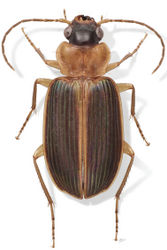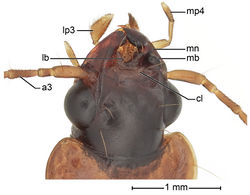Badister amazonus
| Notice: | This page is derived from the original publication listed below, whose author(s) should always be credited. Further contributors may edit and improve the content of this page and, consequently, need to be credited as well (see page history). Any assessment of factual correctness requires a careful review of the original article as well as of subsequent contributions.
If you are uncertain whether your planned contribution is correct or not, we suggest that you use the associated discussion page instead of editing the page directly. This page should be cited as follows (rationale):
Citation formats to copy and paste
BibTeX: @article{Erwin2011ZooKeys147, RIS/ Endnote: TY - JOUR Wikipedia/ Citizendium: <ref name="Erwin2011ZooKeys147">{{Citation See also the citation download page at the journal. |
Ordo: Coleoptera
Familia: Carabidae
Genus: Badister
Name
Badister amazonus Erwin & Ball sp. n. – Wikispecies link – ZooBank link – Pensoft Profile
Holotype
Perú, Loreto, 1.0 km SW boca del Rio Samiria, Vigilante Post 1, 130m, “04°40.5'S, 074°18.9'W" 31 August 1991 (T.L. Erwin & M.G. Pogue)(NMNH: ADP051824, male).
Derivation of specific epithet
The epithet “amazonus” is a singular Latinized masculine noun in apposition, based on the name of the area in which these beetles were found.
Proposed English vernacular name
Amazon Fast-walking Beetle.
Diagnosis
With the attributes of the subgenus Badister, as described by Ball (1959)[1] and as noted above, and large-sized for the genus (mean SBL more than 6.1 mm for both males and females of Badister amazonus; mean SBL less than 5.9 mm for males and females of all other Western Hemisphere species samples). Adults with black head and elytra, the elytron with flavotestaceous base, sutural interneur, lateral margin, and epipleuron, and shiny throughout; prothorax and venter flavotestaceous; appendages testaceous. Microsculpture mesh pattern of head and pronotum isodiametric, surface luster somewhat dull; of elytron, very finely etched transverse lines, surface shiny iridescent. Labial palpomere 3 (Fig. 2, lp3) swollen and triangulate (distal margin obliquely truncate) with a very small pointed knob at apex. Pronotum with lateral margin moderately explanate in anterior half, broadly so posteriorly. Male tarsomeres 1–3 (Fig. 3B, 3C) slightly widened, with rows of adhesive vestiture on ventral surface narrow, confined to anterior half).
Description
(Fig. 1, 2, 3A–C, 4, 5A–C, 6A–D, 7). Size: Moderately large for the subgenus; ABL = 6.2–7.9mm, SBL = 5.36–6.73mm, EW (maximum width) 2.55–3.43mm, LP = 0.97–1.22mm, WP = 1.71–1.91 mm, LE = 3.86–4.84mm. Color: See Diagnosis above. Luster: See Diagnosis above. Head (Fig. 2): clypeus (cl) medially depressed, unisetose laterally, no clear demarcation from frons. Frons markedly depressed, apically with depression extended to eye carina, posteriorly somewhat concave with slight swellings medially raised to occiput; occiput shallowly domed; neck broad. Eye moderately convex; gena short and flat. Antennae and mouthparts typical for genus (see above for details) .
Prothorax. Pronotum (Fig. 1, 2) markedly broad, about twice as long as head (mean LP/LH: 1.683 for males , 1.846 for females), cordiform, margin narrowly explanate with seta at anterior third; base deeply and bilaterally depressed; hind angle slightly obtusely produced and setose; moderately broader than long (mean W/L: 1.71 for males, 1.91 for females); surface medially smooth, slightly rugose laterally medial to explanation.
Pterothorax. Normal for genus.
Elytra. Elytron about same width as head across eyes (mean WH/WE: 0.998 for both sexes), moderately convex, intervals moderately convex and slightly more so laterally, interval 3 bisetose with each setigerous puncture adherent to interneur 2.
Hind wings. Macropterous.
Legs. (Fig. 1). Overall, normal for subgenus. Male front tarsus (Fig. 3B, 3C) with tarsomeres 1–3 slightly dilated and each ventrally (Fig. 3C) with 2–4 rows of white articulo-setae.
Abdominal sterna with normal setation for genus.
Male genitalia (Fig. 5A–5C). Median lobe (ml) with basal lobe (bl) about half length of shaft (sh), basal opening (bo) large. Shaft slender, curved ventrally, dorsally membranous (om) except for two long sclerotized strips (ss) extended from basal lobe to ostial opening (oo); in ventral aspect tapered toward rather broadly rounded apex, preapically with prominent preapical ridge (par), in lateral aspect, ridge a prominently projected point. Parameres (lp, rp)broad, apices subtruncate left paramere (lp) longer than right paramere (rp) about three quarters length of shaft (measured in left lateral aspect). Internal sac with apical ring of rather densely distributed microtrichia, without preapical spines.
Female genitalia. (Fig. 6A–D). Ovipositor with broad laterotergite (lt) and two gonocoxites (gc 1, gc 2); gonocoxite 1 asetose; gonocoxite 2 falcate, base (b) large, broad, blade (bl) rather short, with two dorsal ensiform setae (des), and one ventral ensiform seta (ves), all ensiform setae short; without ventral preapical nematiform setae. Reproductive tract (Fig. 6A, 6B) proximally with short, broad bursa copulatrix (bc), continuous at its distal end with common oviduct (co) and long spermatheca (sp), latter coiled distally; villous canal (vc) extended from near base of spermatheca well up common oviduct; spermathecal gland (sg) bulbous; spermathecal gland duct (sgd) long, slender, attached to spermatheca at base of its coiled portion.
Markedly similar to homologous structures in Badister (Baudia) reflexus LeConte (Will 1998[2]: 99, Fig. 8), which differ as follows: spermatheca with basal uncoiled portion more extensive; distal coiled portion short; spermathecal gland elongate digitiform.
Classification. Ball (1959[1]: 194–195) arranged the species of subgenus Badister in two “complexes” characterized principally by features of the male genitalia and ovipositor gonocoxite 2. The combination of these features in Badister amazonus fits neither complex. Accordingly, we propose here the monobasic amazonus complex, characterized as follows: median lobe of male genitalia dorsally with two long sclerotized strips, internal sac without sclerotized plates or spines; gonocoxite 2 of ovipositor relatively broad basally, ensiform setae relatively short; nematiform setae absent. Additional diagnostic features are: male fore tarsomeres 1–3 (Fig. 3B) relatively slender, not much wider than tarsomeres 1–3 of middle and hind tarsi, fore tarsomere 1 longer than wide, ventral adhesive setae (Fig. 3C) concentrated in anterior half of each tarsomere.
Dispersal potential. These beetles are fully macropterous and are probably capable of flight; they are fast walkers. They also are climbers on grasses (Paspalum spp.).
Way of life. Adults are associated with water: in open grassy marshes, on beaches of black and white water rivers, and in forest swamps at the edges of standing black water ponds in leaf litter on grey clay soil (Kaolin). They are active at night and take cover in the day among grass stems and under flood debris. They are active in May and August–September; no teneral adults were encountered in these months.
Other specimens examined. Perú, Loreto, SW bank of Rio Ucayali, 90m, 4.2089°S, 73.3657°W, 2 September 1991, (T.L. Erwin)(NMNH: ADP051862, female); Pacaya-Samiria National Reserve, Rio Samiria, Cocha Shinguito, 90m, 5.1775°S, 74.6556°W, 21 May 1990 (T.L. Erwin)(NMNH: ADP093676, 128618, females); 1.0 km SW boca del Rio Samiria, Vigilante Post 1, 130m, "04°40.5'S, 074°18.9'W" 31 August 1991–1 November 1991 (G.E. Ball & D. Shpeley)(NMNH: ADP127151, female, 127149, male); 1.0 km SW boca del Rio Samiria, Vigilante Post 1, 130m, "04°40.5'S, 074°18.9'W" 31 August 1991 (T.L. Erwin & M.G. Pogue)(NMNH: ADP051697, 051603, 051336, 051721, 051672, 051743, 051693, 051698, 051722, 051694, 051724, 051692, 051670, 051717, 051718, 051723, 050590, 050589, 050605, 051696, 051720 females and ADP051824, 051630, 051719, 051713, 051826, 051691, 051695 males); 1.0 km SW boca del Rio Samiria, Vigilante Post 1, 130m, "04°40.5'S, 074°18.9'W" 31 August 1991 (T.L. Erwin)(NMNH: ADP051592, 051563, 051544, 051583, 051589, 051559, 051590, 051564, 051567, 051569, 051561, 051581, 051585, 051570, 051584, 051565, 051543 females and ADP051562, 051541, 051591, 051542, 051566, 051588, 051560, 051568 males).
Two males and 12 females at UASM with the following label data: /PERU Dpto. Loreto/ 1 km SW Boca del Rio/Samiria 04°40'29"S, 74°18'55"W 130m/marsh, treading/31.VIII.& 1.IX.91 30–91//T. L. ERWIN EXP./Res. Pacaya-Samiria/G.E. Ball & D. Shpeley/collectors 1991//.
Geographic distribution. (Fig. 7). This species is currently known from only three localities: two along the Río Samiria, and one along the Río Ucayali, Loreto Department, Perú.
Notes. We are not presenting an analysis of variation in body proportions because this species can be separated from all other members of the genus without resorting to such attributes. In regard to the location (latitude/longitude) above for “1.0 km SW del boca Rio Samiria,” Google Earth allows us now to refine what is given on the labels. The actual site is 4.686779°S, 74.336711°W at an elevation of 101m. Also, the female specimen from the Río Ucayali was mistakenly labeled “Río Amazonas.” The river changes names in the vicinity of Iquitos, Perú.
Original Description
- Erwin, T; Ball, G; 2011: Badister Clairville 1806: A new species and new continental record for the nominate subgenus in Amazonian Perú (Coleoptera, Carabidae, Licinini) ZooKeys, 147: 399-417. doi
Other References
- ↑ 1.0 1.1 Ball G (1959) A taxonomic study of the North American Licinini with notes on the Old World species of the Genus Diplocheila Brullé (Coleoptera). Memoirs of the American Entomological Society, 16, iv + 1–258.
- ↑ Will K (1998) A new species of Diplocheila Brullé from North America, with notes on female reproductive tract characters in selected Licinini and implications for evolution of the subgenus Isorembus Jeannel (Coleoptera: Carabidae: Licinini). Proceedings of the Entomological Society of Washington 100: 95-103.
Images
|






